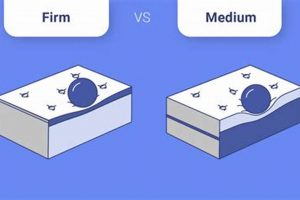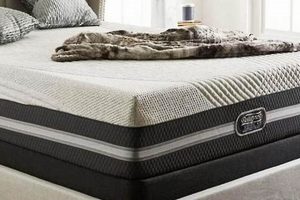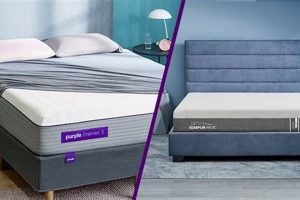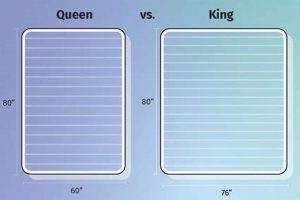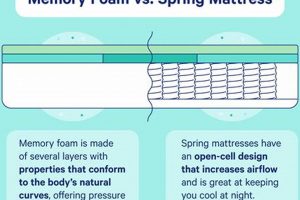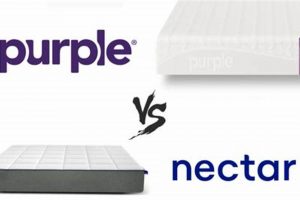The selection of temporary sleeping arrangements for visitors often presents a challenge. Two common options are mattresses designed for folding and inflatable air mattresses. Both aim to provide a comfortable and convenient solution for accommodating guests when permanent bedroom space is limited.
The ability to offer a welcoming sleeping space significantly contributes to guest satisfaction and overall hospitality. Historically, considerations have revolved around factors like ease of storage, set-up time, comfort level, and cost-effectiveness. A suitable guest bed ensures visitors feel valued and well-cared for, enhancing their experience.
An examination of the attributes of folding mattresses versus air mattresses, encompassing their construction, support capabilities, durability, and portability, facilitates a more informed decision. The subsequent sections will delve into these aspects to determine the optimal choice for guest accommodation.
Considerations for Guest Bed Selection
Selecting the appropriate temporary bedding option for guests requires careful evaluation. Prioritizing factors relevant to both comfort and practicality ensures a positive experience for visitors.
Tip 1: Assess Storage Limitations: Evaluate available storage space. Folding mattresses typically require more storage volume than deflated air mattresses. Determine if there is adequate room to store the chosen option when not in use.
Tip 2: Evaluate Intended Frequency of Use: Consider how often the guest bed will be utilized. For frequent use, a higher-quality folding mattress with robust construction may prove more durable than an air mattress. Infrequent use may warrant focusing on more economical options.
Tip 3: Determine Required Level of Support: Understand the potential guest’s needs. Individuals with back problems may require the firmer support offered by some folding mattresses. Air mattresses can offer adjustable firmness, but may lack consistent support across the surface.
Tip 4: Factor in Set-Up Time and Effort: Compare the ease of setting up each type of bed. Folding mattresses generally require minimal setup. Air mattresses require inflation, which can be time-consuming depending on the pump mechanism. Also consider deflation and packing requirements.
Tip 5: Evaluate Durability and Longevity: Research the construction quality of both types of mattresses. Folding mattresses with sturdy frames and high-density foam are likely to last longer. Air mattresses are susceptible to punctures and leaks, potentially requiring replacement sooner.
Tip 6: Prioritize Comfort and Guest Satisfaction: Ultimately, the goal is to provide a comfortable and welcoming sleeping space. Consider the overall feel of each option and choose the one most likely to ensure a good night’s sleep for guests. Reading online reviews can provide valuable insight into the user experience of different brands and models.
By weighing these considerations, a well-informed decision can be made, optimizing both guest comfort and the practicality of the chosen bedding solution.
The subsequent sections will provide a direct comparison of specific features and functionalities to guide the decision-making process further.
1. Support and Comfort
The provision of adequate support and a comfortable sleeping surface are primary considerations when evaluating guest bedding options. These factors directly influence the quality of rest and overall satisfaction experienced by visitors. Choosing between a folding mattress and an air mattress necessitates a careful assessment of their respective strengths and weaknesses in these areas.
- Material Composition and Firmness Levels
Folding mattresses typically employ foam or innerspring construction, offering varying degrees of firmness. Higher-density foams provide enhanced support and conform to the body’s contours. Air mattresses, conversely, utilize inflated chambers, allowing for adjustable firmness. However, the support offered by an air mattress may be less consistent across its surface, particularly near the edges. The choice depends on the guest’s preference for a firm, supportive surface versus a softer, more adaptable feel.
- Surface Texture and Heat Retention
The surface texture of a mattress affects breathability and heat retention. Folding mattresses often feature breathable fabrics that promote airflow and minimize overheating. Air mattresses, particularly those with plastic or vinyl surfaces, may retain more heat, potentially leading to discomfort, especially in warmer climates. Adding a mattress topper to an air mattress can mitigate this issue by improving breathability and wicking away moisture.
- Edge Support and Stability
Edge support is crucial for preventing a feeling of roll-off and facilitating ease of getting in and out of bed. Folding mattresses, especially those with reinforced edges, generally offer better edge support than air mattresses. Air mattresses tend to compress significantly near the edges, reducing stability and making it more difficult for guests with mobility issues.
- Conformity and Pressure Relief
The ability of a mattress to conform to the body’s shape and distribute weight evenly is essential for pressure relief. Memory foam folding mattresses excel in this regard, contouring to the body and reducing pressure points. Air mattresses can offer some degree of conformity, but their support may be less targeted, potentially leading to pressure buildup in certain areas. The selection should consider the guest’s susceptibility to pressure sores or joint pain.
Ultimately, the assessment of support and comfort hinges on individual guest preferences and needs. While folding mattresses may provide more consistent and reliable support, air mattresses offer adjustable firmness. Evaluating these factors ensures a well-informed decision that prioritizes guest satisfaction and promotes restful sleep.
2. Storage Requirements
Storage requirements are a critical factor when determining the optimal guest bedding solution. The physical space available for storing either a folding mattress or an air mattress significantly influences the practicality and convenience of each option.
- Compressed Footprint Variance
The primary distinction lies in the volume occupied when not in use. Air mattresses, when deflated and packed, condense into a relatively small and manageable package, often fitting into a storage bag or box. Folding mattresses, conversely, retain a significant portion of their expanded dimensions even when folded, requiring substantially more storage space. This differential impacts individuals with limited closet space or those residing in smaller dwellings.
- Storage Location Considerations
The designated storage location plays a crucial role. A deflated air mattress can be easily stored in attics, basements, or under beds due to its compact size. Folding mattresses, because of their larger size and weight, typically necessitate readily accessible storage areas such as closets or spare rooms. The convenience of retrieval and deployment hinges on the accessibility of the chosen storage space.
- Weight and Maneuverability during Storage
The weight of each option affects its ease of handling during storage. Air mattresses, being relatively lightweight, can be easily carried and repositioned by most individuals. Folding mattresses, particularly those constructed with heavy-duty frames and dense foam, can be cumbersome and require greater physical effort to move. This factor is especially relevant for individuals with physical limitations or those who frequently rearrange their living space.
- Impact on Living Space Aesthetics
The visual impact of the stored bedding solution contributes to the overall aesthetics of the living space. A neatly packed air mattress can be discreetly tucked away, minimizing its visual presence. A folding mattress, even when folded, may still occupy a noticeable amount of space, potentially detracting from the room’s overall appearance. The consideration of visual impact is particularly relevant for individuals who prioritize a minimalist or uncluttered living environment.
In conclusion, the relative suitability of folding mattresses versus air mattresses is significantly affected by storage constraints. The compact storage footprint of air mattresses provides a distinct advantage in space-limited environments, while the larger dimensions of folding mattresses may be less problematic for those with ample storage capacity. The choice ultimately depends on a careful assessment of available storage space, physical capabilities, and aesthetic preferences.
3. Setup Simplicity
The ease and speed with which a guest bed can be prepared directly impacts the convenience and user experience associated with both folding mattresses and air mattresses. Setup simplicity becomes a significant determinant when evaluating which option is superior for accommodating guests. A complex or time-consuming setup process can create a negative first impression, potentially offsetting any comfort advantages offered by the chosen bedding solution. Conversely, a straightforward setup enhances guest satisfaction and minimizes the burden on the host. For instance, a late-night arrival might necessitate a quick and effortless bedding arrangement to ensure immediate rest for the guest.
Folding mattresses typically require minimal setup: unfolding the mattress is often the only necessary step before it is ready for use. This contrasts with air mattresses, which necessitate inflation, often involving the use of an electric or manual pump. The inflation process can be noisy and time-consuming, particularly for larger air mattresses or when using a manual pump. Furthermore, ensuring the air mattress is inflated to the correct pressure can require adjustments and monitoring. A practical example would involve an elderly guest who might find the process of inflating an air mattress physically challenging, making a folding mattress the more suitable option.
In summary, setup simplicity is a crucial factor in determining the suitability of folding mattresses versus air mattresses for guest accommodation. The immediate availability and ease of use associated with folding mattresses offer a distinct advantage over the inflation requirements of air mattresses. This difference significantly impacts the overall guest experience, influencing both convenience and satisfaction. While air mattresses offer other benefits, the added effort and potential challenges associated with their setup process should be carefully weighed against the simplicity and immediacy provided by folding mattresses.
4. Durability Concerns
The longevity and resistance to damage of guest bedding solutions constitute a critical consideration. “Durability Concerns” directly influence the long-term cost-effectiveness and overall suitability of folding mattresses versus air mattresses. The inherent structural differences between these options dictate their respective vulnerabilities and expected lifespans.
- Puncture and Tear Resistance
Air mattresses are inherently susceptible to punctures and tears due to their reliance on inflated air chambers. Sharp objects, rough surfaces, or even excessive weight can compromise the integrity of the material, leading to leaks and deflation. Folding mattresses, constructed from foam and fabric, are generally more resistant to punctures and tears, offering a more robust and reliable sleeping surface. An example would be a guest inadvertently placing a suitcase with a sharp edge on an air mattress, potentially causing irreparable damage, while a folding mattress would be less vulnerable to such an incident.
- Seam Strength and Air Leakage
The seams of an air mattress represent a common point of failure. Over time, the repeated stress of inflation and deflation can weaken the seams, leading to air leaks. Manufacturing defects can also contribute to seam weakness, reducing the overall lifespan of the mattress. Folding mattresses lack seams in the same critical manner, eliminating this potential point of failure. The gradual deflation of an air mattress due to seam leakage can result in an uncomfortable and disruptive sleeping experience for the guest.
- Frame and Material Degradation
Folding mattresses may experience degradation of their internal support structures or external fabric coverings over prolonged use. The frame, if present, can weaken or warp, while the foam may lose its density and resilience. Similarly, the fabric can tear or fade, affecting the overall aesthetic appeal. However, such degradation typically occurs more gradually compared to the sudden failure associated with air mattress punctures. Proper storage and care can mitigate these effects, extending the lifespan of a folding mattress.
- Resistance to Mold and Mildew
Both types of mattresses are susceptible to mold and mildew growth if exposed to moisture. However, air mattresses, particularly those with internal baffling, can be more difficult to dry completely after exposure to spills or humidity, creating a favorable environment for microbial growth. Folding mattresses can be easier to dry and ventilate, reducing the risk of mold and mildew accumulation. Regular cleaning and proper ventilation are essential for maintaining the hygiene and longevity of both types of mattresses.
The assessment of “Durability Concerns” highlights a significant disparity between folding mattresses and air mattresses. While both options are subject to wear and tear, the inherent vulnerability of air mattresses to punctures and leaks presents a notable disadvantage. The greater resilience and resistance to sudden failure offered by folding mattresses contribute to their long-term cost-effectiveness and suitability as reliable guest bedding solutions. However, proper care and maintenance are crucial for maximizing the lifespan of either option.
5. Portability Factors
The ease with which a guest bed can be transported and relocated, referred to as “Portability Factors,” represents a significant determinant in the assessment of “folding mattress vs air which one is better for guest.” The weight, dimensions, and included carrying mechanisms directly influence the convenience and practicality of each option, particularly in situations involving frequent moves, limited storage space, or accommodating guests in different locations within a residence.
Air mattresses, when deflated, exhibit superior portability due to their reduced size and weight. A deflated air mattress and its accompanying pump can often be packed into a relatively small carrying bag, facilitating easy transport and storage in vehicles or closets. Folding mattresses, in contrast, retain a considerable portion of their original dimensions even when folded, rendering them less manageable for transportation and requiring dedicated storage space. For instance, a host might prefer an air mattress when accommodating guests who are visiting for a short period and then relocating to another destination, as the air mattress can be easily packed and transported with the guest. The weight difference also impacts the ease of maneuvering the guest bed within a home. Repositioning a folding mattress can be a more strenuous task compared to moving a deflated air mattress to a different room.
Therefore, “Portability Factors” significantly contribute to the overall suitability of folding mattresses versus air mattresses as guest bedding solutions. The lightweight and compact nature of deflated air mattresses provide a distinct advantage in situations where transportability and ease of relocation are paramount. However, this advantage must be weighed against other factors, such as comfort, durability, and setup simplicity, to determine the optimal choice for specific guest accommodation needs.
6. Cost Implications
The economic considerations associated with providing temporary sleeping arrangements significantly influence the choice between a folding mattress and an air mattress. “Cost Implications,” encompassing initial purchase price, potential maintenance expenses, and anticipated lifespan, form a crucial component in evaluating “folding mattress vs air which one is better for guest.” The initial investment for both options varies considerably, depending on factors such as material quality, size, and brand reputation. Budget-conscious consumers must weigh the upfront cost against the expected durability and long-term value proposition of each alternative.
Air mattresses generally exhibit a lower initial cost compared to folding mattresses of comparable size and perceived comfort. This lower barrier to entry makes air mattresses an attractive option for those with limited financial resources or infrequent guest accommodation needs. However, the long-term costs associated with air mattresses can potentially exceed those of folding mattresses due to their susceptibility to punctures, leaks, and seam failures, necessitating frequent repairs or replacements. Conversely, while folding mattresses typically command a higher initial price, their greater durability and resistance to damage may result in lower long-term costs, especially with regular use. A practical example involves a family that hosts guests several times a year; the initial savings from purchasing a cheaper air mattress could be negated by the need to replace it every two years, while a higher-quality folding mattress could provide reliable service for five years or more. Furthermore, the need for accessories such as electric pumps for air mattresses adds to the overall expense.
In summary, the selection between folding mattresses and air mattresses based on cost requires a comprehensive evaluation of both initial expenses and long-term economic factors. While air mattresses offer a lower upfront cost, their potential for frequent repairs or replacements can ultimately render them less cost-effective. The greater durability of folding mattresses, despite their higher initial price, may provide a more economical solution over time. A thorough assessment of individual needs, usage patterns, and budget constraints is essential for making an informed decision that balances cost with value and reliability. The long-term value should be prioritized over the initial savings in many cases.
Frequently Asked Questions
This section addresses common inquiries regarding the selection of temporary bedding options for guests, specifically focusing on folding mattresses and air mattresses. The aim is to provide clear, concise, and informative answers to assist in making an informed decision.
Question 1: What are the primary comfort differences between a folding mattress and an air mattress?
Folding mattresses generally offer a more consistent and uniform sleeping surface due to their foam or innerspring construction. Air mattresses, while offering adjustable firmness, can exhibit uneven support and a less stable feel, particularly around the edges.
Question 2: Which option is more suitable for guests with back pain or orthopedic concerns?
A folding mattress with high-density foam or innerspring construction is often recommended for guests with back pain, as it provides firmer and more reliable support. Air mattresses may not offer adequate support for individuals with specific orthopedic needs.
Question 3: What are the storage space requirements for each type of mattress?
Air mattresses, when deflated, require significantly less storage space compared to folding mattresses. This makes air mattresses a more practical choice for individuals with limited storage capacity.
Question 4: How does the setup process differ between a folding mattress and an air mattress?
Folding mattresses typically require minimal setup, involving simply unfolding the mattress. Air mattresses necessitate inflation, which can be time-consuming and may require an electric pump.
Question 5: Which option is more durable and resistant to damage?
Folding mattresses generally exhibit greater durability and resistance to punctures or tears compared to air mattresses. Air mattresses are susceptible to leaks, which can compromise their functionality and lifespan.
Question 6: What is the typical cost comparison between a folding mattress and an air mattress?
Air mattresses generally have a lower initial purchase price compared to folding mattresses. However, the long-term costs associated with air mattresses may be higher due to their lower durability and potential need for frequent replacements.
In summary, the choice between a folding mattress and an air mattress depends on individual priorities and circumstances. Folding mattresses offer consistent comfort and durability, while air mattresses provide portability and space-saving storage. Careful consideration of these factors is essential for selecting the optimal guest bedding solution.
The subsequent section will present a concluding summary, consolidating the key points discussed throughout this analysis to facilitate a well-informed decision.
Conclusion
The preceding analysis has explored the critical attributes of folding mattresses and air mattresses within the context of guest accommodation. Key considerations include comfort, storage requirements, setup simplicity, durability, portability, and cost implications. No single option emerges as universally superior; the optimal choice is contingent upon specific needs and priorities. Folding mattresses offer consistent support and greater durability, while air mattresses provide space-saving storage and enhanced portability. Careful evaluation of individual circumstances, including guest preferences, storage limitations, and budget constraints, is paramount in selecting the most appropriate bedding solution.
Ultimately, the selection of guest bedding represents an investment in hospitality. A well-considered choice reflects a commitment to guest comfort and satisfaction, contributing to a positive and welcoming experience. Prioritizing factors such as support, durability, and ease of use ensures that the chosen solution effectively meets the demands of temporary accommodation. By thoughtfully weighing the advantages and disadvantages of each option, a host can confidently provide a comfortable and convenient sleeping arrangement for valued guests.


